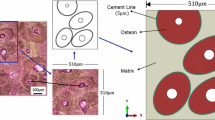Abstract
The aim of the study was to analyze the structure and course of osteons in the compact bone of individual regions of the upper end of the femur and to consider the possible association with the course of typical peritrochanteric fracture lines. The issue of the architecture of this region has been dealt with by a number of authors since the first half of the nineteenth century, but until the present structural analysis it has been examined only by a few authors. We analyzed the structure of bones on specimens prepared by the method of repeated grinding, impregnating and polishing of the bone surface. We grounded and subsequently evaluated the bone in 20 dry specimens of the proximal femur, where the courses of the central vascular canals were described in the region of the femoral neck, the lesser trochanter, the greater trochanter, the intertrochanteric crest and line. The osteons were incorporated into a biomechanical model of the proximal femur and compared with the FEM model and correlation with the distribution of surface stresses was described. Certain areas were identified in the region of the trochanters where the course of osteons coincided with the course of the typical fracture lines of peritrochanteric fractures with typical fragments.











Similar content being viewed by others
References
Benninghof A (1925) Spaltlinien am Knochen, eine Methode zur Ermittlung der Architektur platter Knochen. Ver Anat Ges 34:189–205
Bergmann G, Deuretbacher G, Keller M (2001) Hip contact forces and gait patterns from routine activities. J Biomech 34:859–871
Blaimont P (1968) Contribution à l’étude biomécanique du fémur humain. Acta Med Belgica 34:1–144
Cohen J, Harris WH (1958) The three-dimensional anatomy of Haversian systems. J Bone J Surg 40A:419–434
Duda GN, Schneider E, Chao EYS (1993) Internal forces and moments in the femur during walking. J Biomech 30:933–941
Griffin JB (1982) The calcar femorale redefined. Clin Orthop 164:211–214
Heřt J, Fiala P, Petrtýl M (1993) Structure and loading mode of long bones in man. Acta Chir Orthop Traumat Cechoslovaca 60:199–208
Heřt J, Fiala P, Petrtýl M (1994) Osteon orientation of the diaphysis of the long bone in man. Bone 15:269–277
Hoffmann R, Haas NP (2000) Femur: proximal. In: Rüedi TP, Murphy WM (eds) AO principles of fracture management. Thieme, Stuttgart, pp 445–459
Keyak JH, Rossi SA, Jones KA, Skinner HB (1998) Prediction of femoral fracture load using automated finite element modeling. J Biomech 31:125–133
Koch JC (1917) The laws of bone architecture. Am J Anat 21:177–298
Lange F, Pitzen P (1921) Zur Anatomie des oberen Femurendes. Z Orthop Chir 41:105–134
Lanyon LE (1975) Bone deformation recorded in vivo from strain gauges attached to the human tibial shaft. Acta Orthop Scand 46:256–268
Marique P (1945) Études sur le fémur. Librairie des sciences, Bruxelles, pp 1–180
Merkel F (1874) Betrachtungen über das Os Femoris. Arch Pathol Anat 59:237–256
Mow VC, Ratcliffe A, Woo SLY (1990) Biomechanics of diarthrodial joints. Springer, Heidelberg, pp 155–174
Pauwels F (1935) Der Schenkelhalsbruch. Ein mechanisches Problem. F. Enke, Stuttgart, pp 1–157
Pauwels F (1965) Gesammelte Abhandlungen zur funktionellen Anatomie des Bewegungsapparates. Springer, Heidelberg, pp 392
Peltier LF (1990) Fractures: a history and iconography of their treatment. Norman Publishing, San Francisco, pp 1–273
Peng L, Bai J, Zeng X, Zhou Y (2006) Comparison of isotropic and orthotropic material property assignments on femoral finite element models under two loading conditions. Med Eng Phys 28:227–233
Sinelnikov NA (1937) Spatial architecture of osteons in the diaphysis of the femur in man and other primates. Antrop Zurnal 3:102–115
Taylor SJG, Walker PS (2001) Forces and moments telemetred from two distal femoral replacements during various activities. J Biomech 34:839–848
Acknowledgments
The study was prepared with the support of GAUK 103/2000/C and the MSM 111200003 research project. This work was granted the Young Investigator’s Award at the 16th International Congress of the International Federation of Associations of Anatomists (IFAA) 2004 in Kyoto, Japan.
Author information
Authors and Affiliations
Corresponding author
Rights and permissions
About this article
Cite this article
Báča, V., Kachlík, D., Horák, Z. et al. The course of osteons in the compact bone of the human proximal femur with clinical and biomechanical significance. Surg Radiol Anat 29, 201–207 (2007). https://doi.org/10.1007/s00276-007-0192-6
Received:
Accepted:
Published:
Issue Date:
DOI: https://doi.org/10.1007/s00276-007-0192-6




